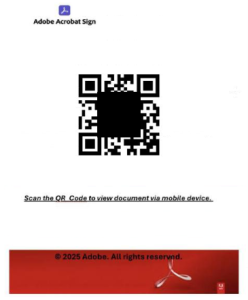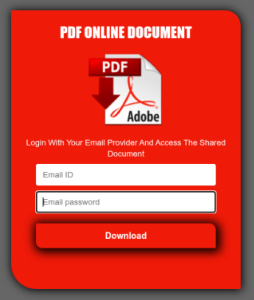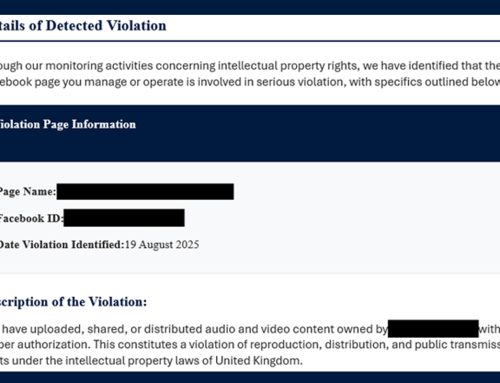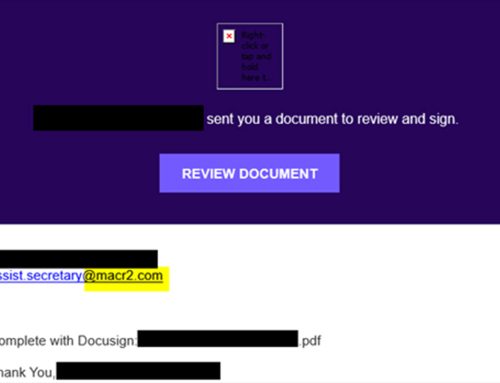HR Quishing Campaign Resurfaces
Scams
May 15, 2025
The NJCCIC recently reported on malicious QR codes used in multiple quishing campaigns impersonating human resources or information technology. The NJCCIC’s email security solution observed a similar quishing campaign attempting to deliver malicious QR codes to New Jersey State employees. Threat actors use Adobe branding and change the sender’s display name to include “HR” along with the recipient’s domain name, despite the EXTERNAL tag indicating that the email originates from outside the organization. They lure their targets with a human resources theme of a revised employee handbook.

If the Adobe PDF attachment is clicked, it will display a one-page document with a QR code, additional Adobe branding, and instructions to scan the QR code on a mobile device to view the document. QR codes are becoming a preferred method for threat actors since they are more likely to be scanned with mobile devices, which are typically less protected against malicious QR codes or links.

Users are unlikely to identify a QR code as legitimate or malicious at first glance. However, they can scan a QR code to display or reveal information or the link without visiting the link. One way is to use the camera feature on the mobile device. Another way is to use a QR code scanner app from the Google Play Store on Android devices or the App Store on iPhone devices. Another method is to save a screenshot of the QR code to the computer and then use an online QR code decoder, such as Google Lens, to display the link. Threat actors may use URL shortening in the initial link to obfuscate the final URL. For this campaign, an online QR code decoder revealed the link, which was confirmed in the above image as malicious and redirected to a final URL.

If the QR code is scanned and the link is visited, the target is prompted to log into a phishing landing page with Adobe branding that appears legitimate. If the target enters their email address and password to download the purported document, the account credentials risk being compromised and stolen by threat actors in the background. This campaign can also potentially result in account takeover, access to sensitive information, data exfiltration, malware installation, and other malicious activities. All organizations should remain vigilant with the rising threat of malicious QR codes.
Recommendations
- Confirm the QR code is legitimate and trustworthy before scanning it, particularly in unsolicited messages or public places, especially with company-issued equipment, services, and software.
- Use a device’s camera feature, QR code scanning app, or QR code decoder to show the full URL before visiting it. Disable features to automatically execute actions such as opening links or downloading files.
- Refrain from scanning QR codes that have been physically or digitally tampered with.
- When in doubt, manually type a known and trusted URL (obtained from official sources) into the browser.
- Provide personal or financial information or transfer money to only legitimate and verified websites.
- Regularly update your mobile device and its apps.
- Run updated and reputable anti-malware programs on devices.
- Use strong passwords and enable MFA on your accounts.
- Report malicious cyber activity to the FBI’s IC3 and the NJCCIC.
Multiple vulnerabilities have been discovered in Ivanti Endpoint Manager Mobile, the most severe of which could allow for remote code execution. Ivanti Endpoint Manager Mobile (EPMM) is a unified endpoint management solution that enables organizations to securely manage and monitor mobile devices, applications, and content across multiple platforms from a centralized interface. Successful exploitation of the most severe of these vulnerabilities could allow for remote code execution in the context of the system. Depending on the privileges associated with the system, an attacker could then install programs; view, change, or delete data.
THREAT INTELLEGENCE:
There are a limited number of customers whose solution has been exploited at the time of disclosure.
SYSTEMS AFFECTED:
- Ivanti Endpoint Manager Mobile 11.12.0.4 and prior
- Ivanti Endpoint Manager Mobile 12.3.0.1 and prior
- Ivanti Endpoint Manager Mobile 12.4.0.1 and prior
- Ivanti Endpoint Manager Mobile 12.5.0.0 and prior
RISK:
Government:
- Large and medium government entities: High
- Small government entities: Medium
Businesses:
- Large and medium business entities: High
- Small business entities: Medium
Home users: Low
TECHNICAL SUMMARY:
Multiple vulnerabilities have been discovered in Ivanti Endpoint Manager Mobile, the most severe of which could allow for remote code execution. Details of these vulnerabilities are as follows:
Tactic: Initial Access (TA0001):
Technique: Exploit Public-Facing Application (T1190):
- A remote code execution vulnerability in Ivanti Endpoint Manager Mobile allowing attackers to execute arbitrary code on the target system. (CVE-2025-4428)
Details of lower severity vulnerabilities:
- An authentication bypass in Ivanti Endpoint Manager Mobile allowing attackers to access protected resources without proper credentials. Exploitation of this vulnerability can lead to exploitation of CVE-2025-4428 (CVE-2025-4427)
Successful exploitation of these vulnerabilities could allow for remote code execution in the context of the system. Depending on the privileges associated with the system, an attacker could then install programs; view, change, or delete data.
RECOMMENDATIONS:
We recommend the following actions be taken:
- Apply appropriate updates provided by Ivanti to vulnerable systems immediately after appropriate testing. (M1051: Update Software)
- Safeguard 7.1 : Establish and Maintain a Vulnerability Management Process: Establish and maintain a documented vulnerability management process for enterprise assets. Review and update documentation annually, or when significant enterprise changes occur that could impact this Safeguard.
- Safeguard 7.2: Establish and Maintain a Remediation Process: Establish and maintain a risk-based remediation strategy documented in a remediation process, with monthly, or more frequent, reviews.
- Safeguard 7.4: Perform Automated Application Patch Management: Perform application updates on enterprise assets through automated patch management on a monthly, or more frequent, basis.
- Safeguard 7.5 : Perform Automated Vulnerability Scans of Internal Enterprise Assets: Perform automated vulnerability scans of internal enterprise assets on a quarterly, or more frequent, basis. Conduct both authenticated and unauthenticated scans, using a SCAP-compliant vulnerability scanning tool.
- Safeguard 7.7: Remediate Detected Vulnerabilities: Remediate detected vulnerabilities in software through processes and tooling on a monthly, or more frequent, basis, based on the remediation process.
- Safeguard 12.1: Ensure Network Infrastructure is Up-to-Date: Ensure network infrastructure is kept up-to-date. Example implementations include running the latest stable release of software and/or using currently supported network-as-a-service (NaaS) offerings. Review software versions monthly, or more frequently, to verify software support.
- Safeguard 18.1: Establish and Maintain a Penetration Testing Program: Establish and maintain a penetration testing program appropriate to the size, complexity, and maturity of the enterprise. Penetration testing program characteristics include scope, such as network, web application, Application Programming Interface (API), hosted services, and physical premise controls; frequency; limitations, such as acceptable hours, and excluded attack types; point of contact information; remediation, such as how findings will be routed internally; and retrospective requirements.
- Safeguard 18.2: Perform Periodic External Penetration Tests: Perform periodic external penetration tests based on program requirements, no less than annually. External penetration testing must include enterprise and environmental reconnaissance to detect exploitable information. Penetration testing requires specialized skills and experience and must be conducted through a qualified party. The testing may be clear box or opaque box.
- Safeguard 18.3: Remediate Penetration Test Findings: Remediate penetration test findings based on the enterprise’s policy for remediation scope and prioritization.
- Apply the Principle of Least Privilege to all systems and services. Run all software as a non-privileged user (one without administrative privileges) to diminish the effects of a successful attack. (M1026: Privileged Account Management)
- Safeguard 4.7: Manage Default Accounts on Enterprise Assets and Software: Manage default accounts on enterprise assets and software, such as root, administrator, and other pre-configured vendor accounts. Example implementations can include: disabling default accounts or making them unusable.
- Safeguard 5.5: Establish and Maintain an Inventory of Service Accounts: Establish and maintain an inventory of service accounts. The inventory, at a minimum, must contain department owner, review date, and purpose. Perform service account reviews to validate that all active accounts are authorized, on a recurring schedule at a minimum quarterly, or more frequently.
- Vulnerability scanning is used to find potentially exploitable software vulnerabilities to remediate them. (M1016: Vulnerability Scanning)
- Safeguard 16.13: Conduct Application Penetration Testing: Conduct application penetration testing. For critical applications, authenticated penetration testing is better suited to finding business logic vulnerabilities than code scanning and automated security testing. Penetration testing relies on the skill of the tester to manually manipulate an application as an authenticated and unauthenticated user.
- Architect sections of the network to isolate critical systems, functions, or resources. Use physical and logical segmentation to prevent access to potentially sensitive systems and information. Use a DMZ to contain any internet-facing services that should not be exposed from the internal network. Configure separate virtual private cloud (VPC) instances to isolate critical cloud systems. (M1030: Network Segmentation)
- Safeguard 12.2: Establish and Maintain a Secure Network Architecture: Establish and maintain a secure network architecture. A secure network architecture must address segmentation, least privilege, and availability, at a minimum.
- Use capabilities to detect and block conditions that may lead to or be indicative of a software exploit occurring. (M1050: Exploit Protection)
- Safeguard 10.5: Enable Anti-Exploitation Features: Enable anti-exploitation features on enterprise assets and software, where possible, such as Microsoft® Data Execution Prevention (DEP), Windows® Defender Exploit Guard (WDEG), or Apple® System Integrity Protection (SIP) and Gatekeeper™.
CVE:
https://cve.mitre.org/cgi-bin/cvename.cgi?name=CVE-2025-4428
https://cve.mitre.org/cgi-bin/cvename.cgi?name=CVE-2025-4427





